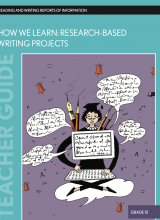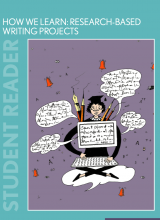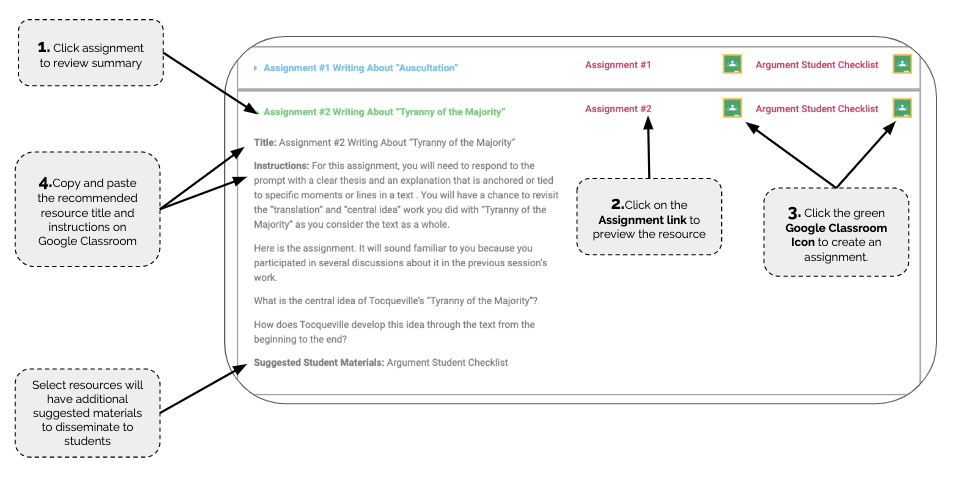How We Learn: Research-Based Writing Projects - Grade 12
In this unit, “Secrets of a Mind-Gamer”—a text from Joshua Foer’s bestselling book Moonwalking with Einstein—provides a model and launch pad for a student excursion into the world of acquiring difficult skills. Foer arrived at the finals of the USA Memory Championship as a reporter. A year later, he returned as a participant to become the U.S. record holder in speed cards. His account of his experience serves a double purpose: It introduces students to the notion of acquiring a difficult skill and it stands as an example of investigative report writing that students can study and emulate.


Table of Contents
Writing Tasks
Title: Tracking Foer
Teacher Manual Instructions:
Review the tracking form with the class and explain that the work of the next few sessions will be set aside so that students can complete this task.
In an effort to model smart approaches to the work of this part of the unit, you might decide to show students a way to mark, as they are reading, passages in the text that feature key people or key terms or that contain significant moments.
Title: The First Assignment Retelling “Secrets of a Mind-Gamer”
Teacher Manual Instructions:
Session 4
Answer any questions students have about the assignment or the work to be done. Point out to students that this work is, to a degree, “writing-to-think” work, and while students should work deliberately and carefully on it, it is also a place to record questions and uncertainties about the text. If necessary, consider borrowing a student’s tracking notes to model how a student might consult their notes, the text, and their annotations to get started with this work.
Title: The Second Assignment Writing About Foer’s Message
Teacher Manual Instructions:
Session 5
Review the assignment with the class. Point out to students that Foer’s text is doing two things at the same time: On one level, it seems as though he is simply telling a story about his experiences entering the Memory Championship contest. On a second level, though, Foer is making both explicit and implicit arguments about how we learn and acquire new skills. This task is focused on uncovering and clarifying that second aspect of Foer’s work.
Title: The Third Assignment Writing About Foer’s Method
Teacher Manual Instructions:
Session 6
Title: Sub-Assignment #1 Identifying a Skill to Learn
Teacher Manual Instructions:
Session 14
Title: Sub-Assignment #2 Examining Your Assumptions
Teacher Manual Instructions:
Session 15
Title: A “Before You Begin Writing” Task Wrapping Up the Research
Teacher Manual Instructions:
Session 23
Title: Sub-Assignment #3 What Did You Learn From Your Interviews?
Teacher Manual Instructions:
Session 24
Title: Sub-Assignment #4 What Did You Learn From the Books and Articles You Read?
Teacher Manual Instructions:
Session 25
Title: Sub-Assignment #5 Writing the Report
Teacher Manual Instructions:
Session 26
Title: A Brief Revision Task Imitating Sentences
Teacher Manual Instructions:
Session 28
Charts for Discussion
Title: Structure of “Secrets of a Mind-Gamer”
Teacher Manual Instructions:
Session 8
When there seems to be consensus among the group, jot the line numbers, title, and notes on a chart titled “Structure of ‘Secrets of a Mind-Gamer.’” (In cases where consensus is hard to come by, don’t hesitate to build two or more charts so that competing readings also receive representation.)
Checks for Understanding
Title: Sketching the Sequence
Teacher Manual Instructions:
Session 3
The closing meeting of Session 3 should be devoted to a whole-group negotiation of the “Sketching the Sequence” work students completed. During this discussion, work with the class to develop a “class-version” of that work. Capture this on a chart and post it in the room so that it can be referenced easily in the work ahead.
Title: Retelling Foer
Teacher Manual Instructions:
Session 4
Ask students to take a minute to add any additional notes to their quick writes. Remind them to add page and line numbers of moments they described if they have not done so already.
Invite the class to work with you to generate a whole-class reconstruction or retelling of the text. This retelling should reflect the class’s sense of what is most significant in the text. (For this reason, each class’s retelling will inevitably be somewhat different.)
Note: The level of understanding that students are expected to show at this point is more than simply “the gist” of the text, but does not need to be “mas- tery.” A retelling is focused chiefly on the straightforward, literal understanding of key moments in the text—for example, first this happened, then this was discussed, then the author talked about X. Students will dig deeper into the text in the next sessions. For this reason, do not spend more time than necessary on this discussion.
Capture the results of this retelling on a chart titled “Retelling Foer” and ask students to copy the class’s retelling in their notebooks as well (or to make any necessary additions or adjustments to their earlier writing).
Title: Questions About “Secrets of a Mind-Gamer”
Teacher Manual Instructions:
Session 4
During the discussion, allow students to address any appropriate questions that they generated while completing the retelling. If there are larger questions that arise—ones that seem appropriate for the later discussion about “what Foer is showing us about learning something difficult” (Sessions 5-7)—consider beginning a “Questions About ‘Secrets of a Mind-Gamer’” chart to allow students to chart some of their big questions about the text. This chart provides a central place to capture these ideas without needing to discuss them at the time they are recorded: Instead, they can be returned to during appropriate whole-class discussions.
Title: What Foer Tells Us About Learning
Teacher Manual Instructions:
Session 5
Briefly reconvene the class and invite volunteers to share a few of the arguments they see Foer making.
Resist the urge to discuss these arguments at this time. Instead, view this as an opportunity to share ideas and examples that will help the rest of the class obtain a clearer idea of what an argument can look like in the text.
Capture these arguments in the form of brief statements on a chart titled “What Foer Tells Us About Learning.”
Allow students to add to the “Questions About ‘Secrets…’” chart if necessary. Return to student questions as appropriate in the discussion during Session 7.
Title: Skills to Learn
Teacher Manual Instructions:
Session 12
Convene a whole-class discussion about skills ideas. Throughout the discussion, capture students’ ideas on a chart titled “Skills to Learn.”
Title: Revisiting Foer’s Methods
Teacher Manual Instructions:
Session 13
Suggest to the class that the content of the chart supplies them with two kinds of useful insights:
1. A model and a description of what someone did to learn something difficult; and
2. A sense of “grain size”—in other words, a model of the degree of detail and specificity students need to be thinking at if they are to execute a learning project successfully.
Title: Short Assignments for The Learning Project
Teacher Manual Instructions:
Session 16
Reconvene the class and ask volunteers to share the short assignment items they have on their lists.
Capture these on a chart titled “Short Assignments for The Learning Project.” The goal here is to generate a long list of short assignments. This “master” list will be important as a repository of assignment ideas that students can consult as they map out the work ahead.
Ask students to review their own list of short assignments after several people have shared theirs: What new ideas do they have after listening to each other? What other tasks, assignments, or areas of investigation do they want to add to their lists? Give students a moment to revise their plans.
Independent Reading
Title: Book Interview
Instructions:
Display a copy of the “Book Interview” sheet for the class to see and distribute copies to students.
Using one of the books from the classroom library, model for students how to interview a book and how to fill out the sheet. Answer any questions students have about the form and its terminology.
Give students time to interview three books and to enter their findings on the “Book Interview” sheet.
Title: Book Pass
Instructions:
Organize students’ desks into a circle (or, if this is not possible, determine a very clear path for books to pass through the group).
Explain the purpose of a book pass:
A book pass is another way to expose students to the texts available in the classroom library. A book pass requires students to use their book interviewing skills. A book pass is a chance for students to find titles to add to their “Books I’d Like to Read” list.
Display a copy of the “Book Pass” for the class to see and pass out copies to students.
Demonstrate for the class how a person goes about making an entry on the form. Since students will need to write quickly, show how an author can be listed just by last name and first initial, and demonstrate how a student can abbreviate a long title if necessary. What matters is that they have enough information to track down the book again later if they need to.
Give each student one book (or magazine). Tell them it doesn’t matter which text they start with, because they will see all—or at least many of—the books. (Be sure you have one title for each student in the circle.)
Choose a direction for passing.
After students receive a book, they should immediately record the author’s name (if the text is a book) and title on the “Book Pass” form.
Give students one minute to interview each book following the procedure established in the previous session.
At the end of one minute, call “pass.” At this time, students should make an entry in the comments column and pass the book to the next student.
Continue the book pass until each student has interviewed all the books.
Title: Book Recommendation
Instructions:
Distribute copies of the “Book Recommendation” form to students and give them time to craft or begin crafting their first review. Students can choose to write about a book they’ve completed recently or one they remember well from past reading.
Title: Goals for My Reading Life
Instructions:
Display a copy of “Goals for My Reading Life” for the class to see and distribute copies to students.
Use this time to review how to fill out the goals sheet. Be sure to show students how they can use the charts to generate ideas for answers to the “Goals” questions.
Take a moment to stress the value and function of the “Books I’d Like to Read” list. Point out that this list is a tool that serves the same function as a bedside table for some readers: It is a place to store up titles or books that are “next in line.” Remind the class that readers constantly have their eyes open for “next” texts. A “Books I’d Like to Read List” is a way to prevent aimless and unproductive castings around for new reading materials. It’s a planning tool.
Explain that at the beginning of each marking period, each student will fill out a new goals sheet; at at the end of each marking period, students will take a few minutes to review their goals statements and reflect on their efforts to meet them.
Answer any questions students have about the “Goals for My Reading Life” forms.
Give students time to complete the form and set a deadline for submission. You may decide to photocopy these to keep a set for yourself. Return the forms to students during the next session and have them attach the form to a page in their notebook or save it for their student portfolio (see Creating a Student Portfolio).
Title: Reading Log
Teacher Manual Instructions:
Show students how to set up a “Reading Log” in their notebook. They should be sure to enter it in their table of contents. You may decide to distribute sticky notes so that students can flag this page. Use the model on the next page to guide your efforts.
Notice the column titled “Date Completed/# of Pages Read.” This column is a place for students to record, and receive credit for, the reading of texts that did not require a “cover-to-cover” experience. Be sure to point out that reading sections of several texts for specific purposes is not the same as skipping aimlessly from book to book to book. The former often indicates purposefulness and interest; the latter can indicate confusion or disengagement.
After students have set up the reading log—including proper headings, creating the grid, etc.—demonstrate how to make an entry.
Answer any questions students have about the log.
Remind students that the reading log is a tool to be used in conjunction with the “Goals” sheets. Students track their reading in the log and then use the log to evaluate their progress toward their goals.
If you plan to use student portfolios this year, consider introducing them at this time using some version of the information in the section that follows. Review Creating a Student Portfolio in advance to be sure you have thought through some of the important questions for portfolio work.
Unit Resources
Title: The First Assignment: Retelling “Secrets of a Mind-Gamer”
Title: The Second Assignment: Writing About Foer’s Message
Title: The Third Assignment: Writing About Foer’s Methods
Title: Internet-Based Resources: The Scholarly Article
Title: Library Resources: Searching For, and Within, Books
Title: Sub-Assignment #1: Identifying a Skill to Learn
Title: Sub-Assignment #2: Examining Your Assumptions
Title: A “Before You Begin Writing” Task”: Wrapping Up the Research
Title: Sub-Assignment #3: What Did You Learn From Your Interviews?
Title: Sub-Assignment #4: What Did You Learn From the Books and Articles You Read?
Title: Grades 11 and 12 – Interpretive_Argument Rubric
Title: Grades 11 and 12 – Informational_Explanatory Rubric
Title: Scaffolds and Modifications: Descriptions and Use
